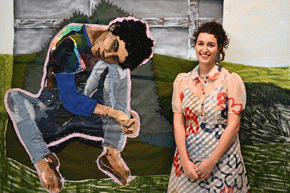Mysterious handprint, moat discovered by Jerusalem’s Old City walls
Archaeologists discovered the remains of a moat and a mysterious hand imprint outside the walls of Jerusalem’s Old City, the Israel Antiquities Authority announced on Wednesday morning.

An imprint of a hand discovered carved into a rock in Jerusalem. Photo by Yoli Schwartz/Israel Antiquities Authority
The rock-hewn moat — believed to date back to the 10th century or earlier — was discovered below street level during excavations outside the northern walls of the Old City ahead of planned infrastructure work. An unexplained carved hand imprint was discovered at one spot carved in the moat wall.
Antiquities Authority officials explained that this moat was not filled with water in the manner of better-known European fortifications. Rather, its width and depth would have posed an obstacle for an attacking army while the city’s defenders could attack from the top of the wall.
“Armies trying to capture the city in the Middle Ages, had to cross the deep moat and behind it two additional thick fortification walls, whilst the defenders of the city on the walls rained down on them fire and sulfur,” explained Dr. Amit Re’em, the Antiquities Authority’s Jerusalem regional director.
“As if this wasn’t enough, there were secret tunnels in the fortifications, some of them uncovered by the Israel Antiquities Authority archaeologists in previous excavations, whereby the city defenders could emerge into the moat and attack the enemy by surprise, and then disappear back into the city,” he added.
Re’em noted that the moat is consistent with historical descriptions of the arrival of the first Crusader army in 1099.
“Exhausted by the journey, they stood opposite the huge moat, and only after five weeks succeeded in crossing it with deploying tactics and at the cost of much blood, under heavy fire from the Moslem and Jewish defenders,” Re’em said.
The archaeologists have not deciphered the meaning of the hand carving. “Does it symbolize something? Does it point to a specific nearby element? Or is it just a local prank? Time may tell,” said the researchers.
The iconic walls and gates of Jerusalem’s Old City were built in the 16th century by Ottoman Sultan Suleiman I. Work on the walls was completed in 1541. The walls are designated as a World Heritage site by the United Nations Educational, Scientific and Cultural Organization. Walking along its ramparts is a popular tourist activity.
“In the eras of knights’ battles, swords, arrows, and charging cavalry, the fortifications of Jerusalem were formidable and complex, comprising walls and elements to hold off large armies storming the city,” Re’em said.









The hand is a Christian crusader symbol and still used in the UK.